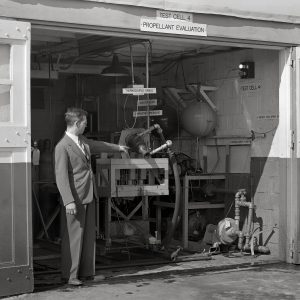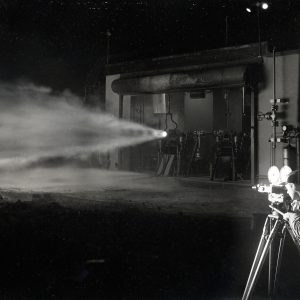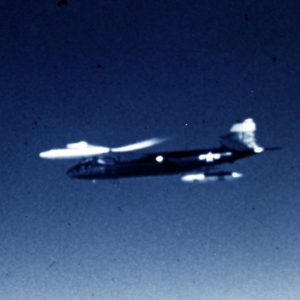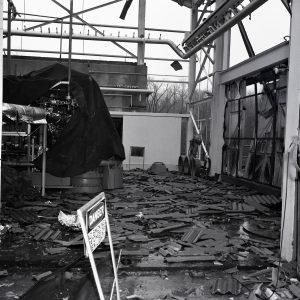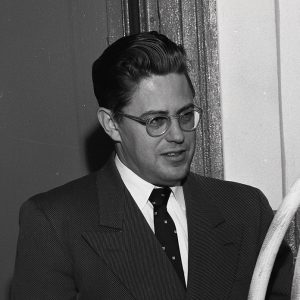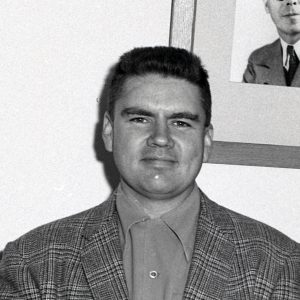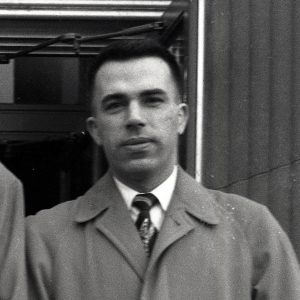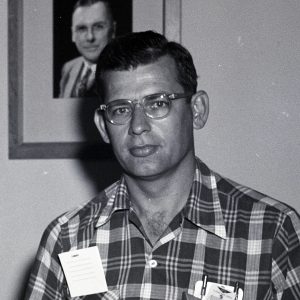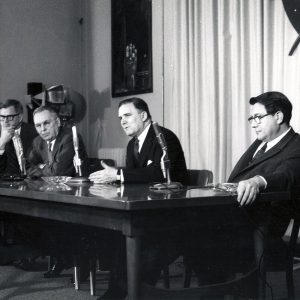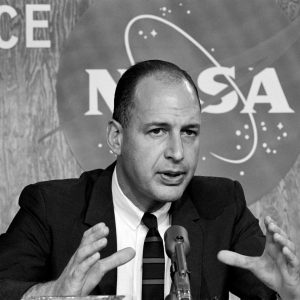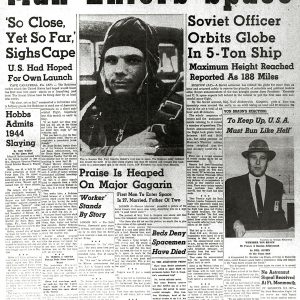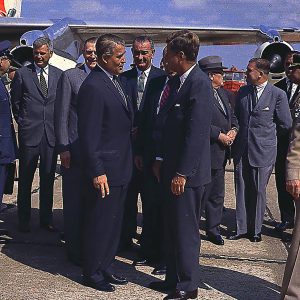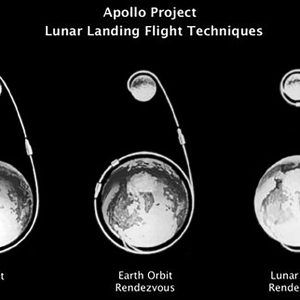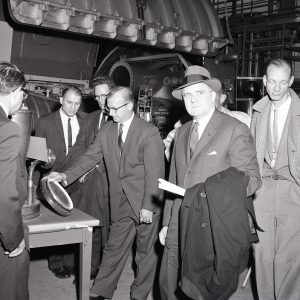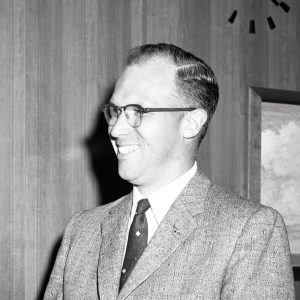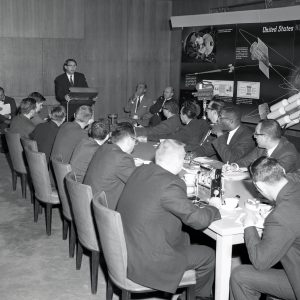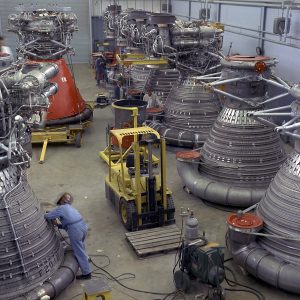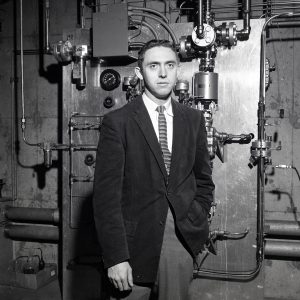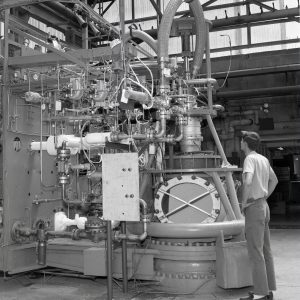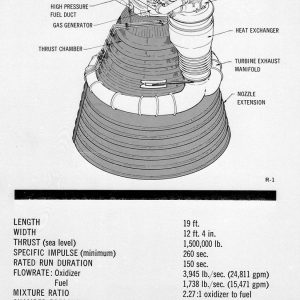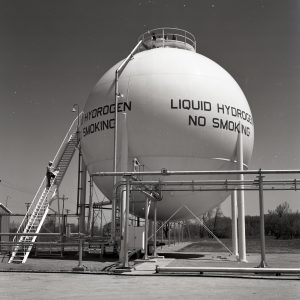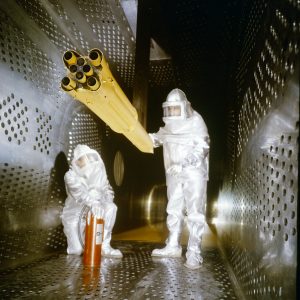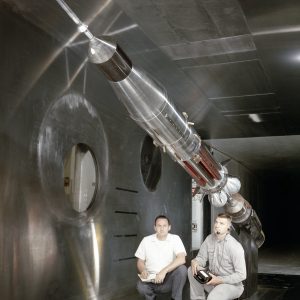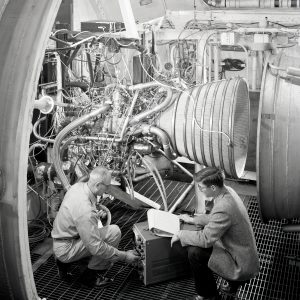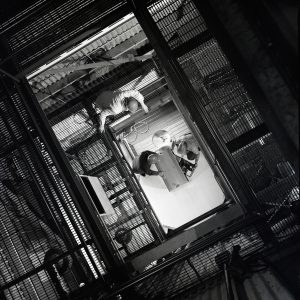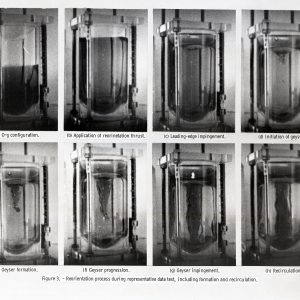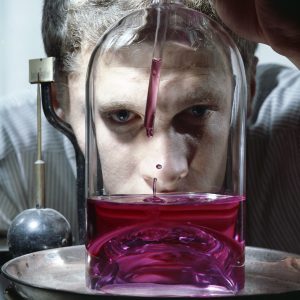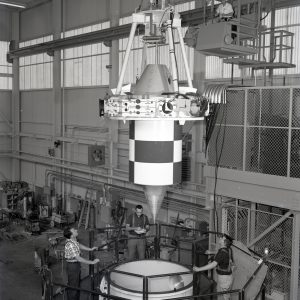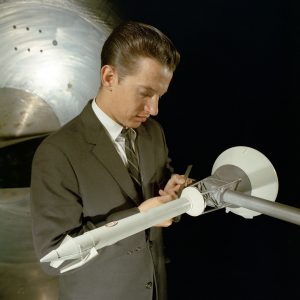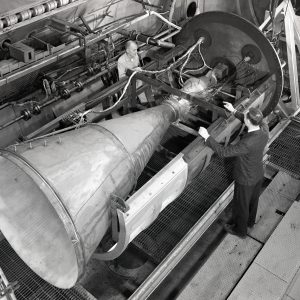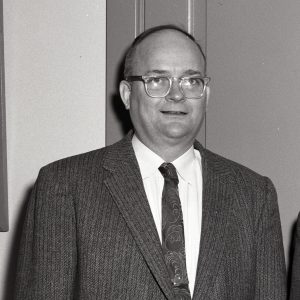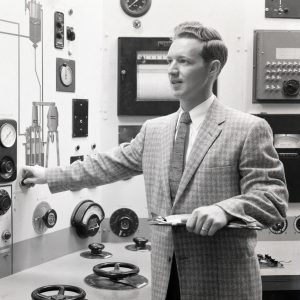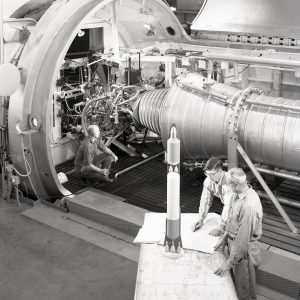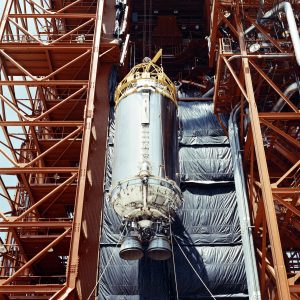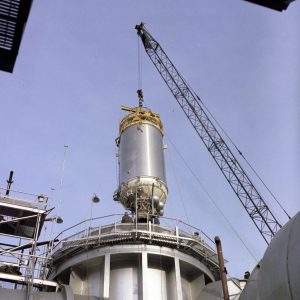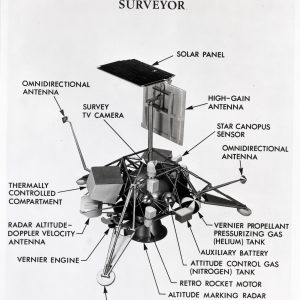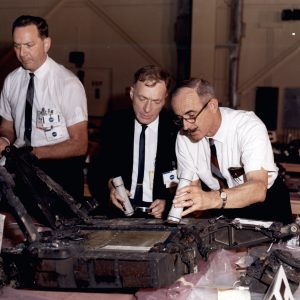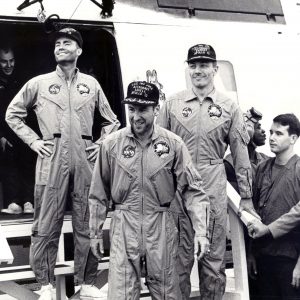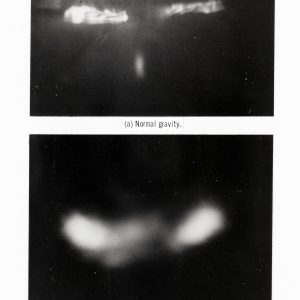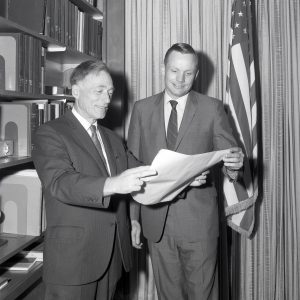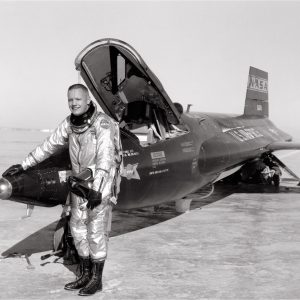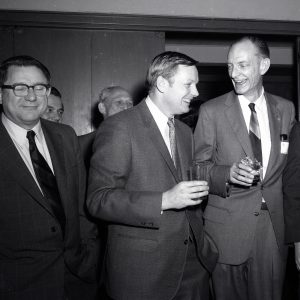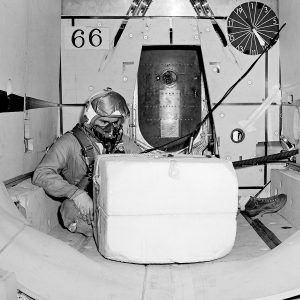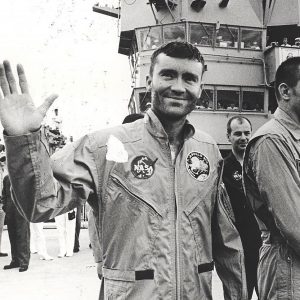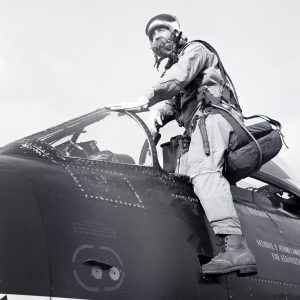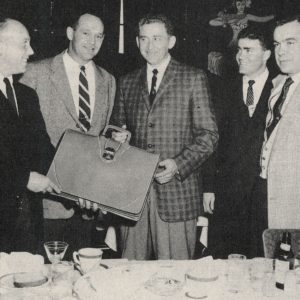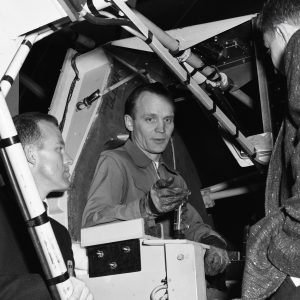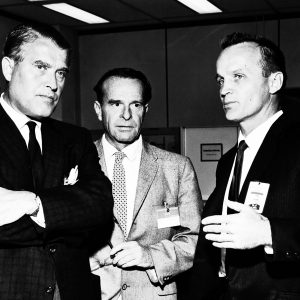Glenn Impact on the Apollo Program
During the 1950s and 1960s, Glenn Research Center made key scientific, technological, and managerial contributions that impacted both the formation and success of NASA’s Apollo Program. Center employees, both renowned and obscure, were among the thousands of individuals across the country who played a role in Apollo’s unprecedented achievements.
Overview
The success of the Apollo 11 mission in July 1969 would likely not have been possible without NASA’s decision in 1959 to utilize upper stage vehicles fueled with liquid hydrogen. This determination stemmed from an effort that began a decade earlier at the Lewis Flight Propulsion Laboratory (today, Glenn Research Center) to transform the lightweight, high-energy hydrogen into a functional propellant. Lewis personnel transferred to Headquarters to help shape the Apollo Program; resolved many technical issues involving each stage of the Saturn V; managed the vehicles that launched lunar exploration spacecraft; investigated the Apollo 1 and 13 accidents; and went on join the Apollo astronaut corps.
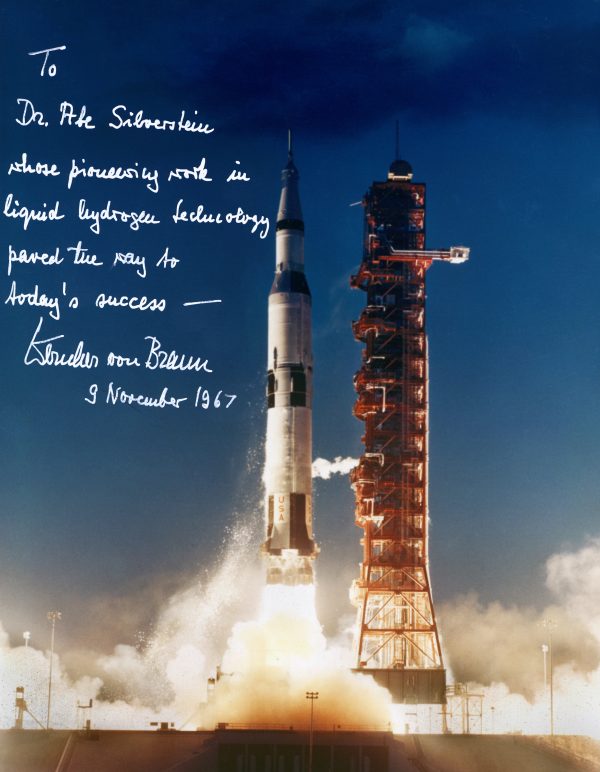
Documents
- Lewis Apollo Contributions press release (1969)
- Lewis Shares in Apollo Pride (1969)
- Lewis Played Role in Apollo Success (1979)
The Hydrogen Foundation
Glenn originated during World War II as a National Advisory Committee for Aeronautics (NACA) research laboratory dedicated to aircraft engines. Its aeropropulsion work included the study of fuels. In 1945, the laboratory reorganized to address the new jet propulsion and missile technologies that had emerged during the War. A small contingent of fuels researchers began studying experimental rocket engines and the use of different highly reactive liquids as propellants. They intentionally avoided hydrogen since the military was then sponsoring hydrogen research at other institutions. The group used a set of small cinderblock test cells, referred to as the Rocket Lab, to study basic issues such as combustion, cooling, fuel injection, and nozzle design while simultaneously performing theoretical studies of a variety of high-energy liquid propellants.
In 1949, chief of research, Abe Silverstein, expanded the rocket research. The group increasingly concentrating on hydrogen—which the military had by then forsaken. Lewis researchers began increasing the size of their experimental engines and in late 1954 successfully fired a 5,000-pound thrust liquid hydrogen/liquid oxygen engine. In early 1955, Silverstein and Eldon Hall authored a report that forecast exceptional performance of a liquid-hydrogen-powered aircraft. By the end of the year, Lewis initiated a yearlong crash program for the Air Force to utilize hydrogen in a J–65 engine. This resulted in a series of successful flight tests on a B–57 Canberra in early 1957. Meanwhile, Pratt & Whitney was asked to design a new engine specifically to handle liquid hydrogen. Although, hydrogen aircraft never came to fruition, the Lewis research and Pratt & Whitney development led to the first commercial liquid hydrogen rocket engine, the RL–10.
Documents
- Liquid Hydrogen as a Propulsion Fuel, 1945-1959
- Liquid Hydrogen as a Jet Fuel for High-Altitude Aircraft (1955)
- Hydrogen for Turbojet and Ramjet Powered Flight (1957)
- Lewis Fuel Combos Used on Saturn (1961)
Getting Apollo Running
The Soviet Union’s launch of Sputnik in the fall of 1957 led to the incorporation of the NACA research laboratories into the new NASA space agency in October 1958. Key members of the Lewis staff, including Newell Sanders (advanced technologies), DeMarquis Wyatt (spaceflight systems), Edgar Cortright (lunar and planetary), Harold Finger (nuclear), John Sloop (spaceflight systems), Adelbert Tischler (propulsion), William Fleming, John Disher (advanced manned missions), and Eldon Hall, transferred to Headquarters to plan NASA’s initial space missions. The two men with the most immediate impact on Apollo, however, were Silverstein and George Low. Silverstein was responsible for all of NASA’s space activities during NASA’s first three years and oversaw the Space Task Group’s (STG’s) human undertakings. Low served as the liaison between the STG and Headquarters. Others from Lewis involved with the STG included Scott Simpkinson, G. Merritt Preston, Glynn Lunney, Dugald Black, Warren North, and Gerald Pessman.
In August 1958, Silverstein began negotiations to transfer management of Rocketdyne’s 1.5-million-pound thrust F–1 engine (later used on Saturn V) from the Air Force to NASA. That same month, Silverstein led a joint military and NASA advisory committee to start identifying the types of launch vehicles and engines that the new space agency would require. Del Tischler led the committee’s panel, dealing specifically with high-energy upper stages. These meetings led to the military’s decision that fall to sponsor the hydrogen-fueled Centaur stage and the Saturn missiles proposed by General Dynamics and the Army Ballistic Missile Agency (future Marshall Spaceflight Center), respectively. Afterwards, Silverstein served on a working group that outlined a multidecade spaceflight program, which included an eventual lunar landing. Their report to President Eisenhower recommended pursuit of the Saturn, Atlas-Centaur, and Nova rockets in conjunction with upper stages.
Perhaps most importantly, Silverstein chaired the Saturn Vehicle Team, referred to as the Silverstein Committee, to select vehicles for the Saturn Program, which the Army had recently transferred to NASA. In December 1959, Silverstein, who was intimately aware of Lewis’ hydrogen work, convinced Wernher von Braun that Saturn’s upper stages must use the high-energy liquid hydrogen. Although, there were no hydrogen vehicles yet in operation, their anticipated performance benefits would be needed to beat the Soviets to the Moon. This led to NASA’s 1960 contract with Rocketdyne to develop the 150,000-pound thrust J–2 engine that would ultimately power Saturn V’s S–II and S–IVB stages. The liquid hydrogen and liquid oxygen-fueled J–2 would share much of the same technology and developmental problems as its smaller predecessor, the RL–10.
Documents
- Lewis Men at Headquarters (1959)
- Report on Saturn Development Plan (1959)
- George Low Spurred Moon Landings (2019)
In July 1960, Silverstein, who had previously named Project Mercury, continued his mythological naming convention by designating the Moon mission as Apollo. At that point, NASA considered Apollo to be a human journey around the Moon that would lay the groundwork for future landings. George Low, however, argued that the lunar landing should take precedence, and in October 1960, obtained Silverstein’s permission to establish a team to identify the options and requirements for such a mission. NASA presented their findings on February 7, 1961 shortly after President Kennedy’s inauguration.
The President’s first four months in office witnessed a series of Cold War setbacks, including the Soviet Union’s successful orbiting of Yuri Gagarin. In April, Kennedy asked Vice President Lyndon Johnson to meet with NASA and military officials to determine a method of demonstrating the nation’s technological superiority over the Soviets. Based on Low’s findings, NASA leaders, including Silverstein, reported that the only feasible “first” in space would be a lunar landing. The President announced his decision to pursue the mission to Congress on May 25, 1961.
Documents
- Silverstein on Apollo Naming (1962)
- Low Memo on Apollo Working Group (1960)
- Plan for Manned Lunar Landing (1961)
- Johnson Evaluation of the Space Program (1961)
- Kennedy Urgent National Needs Speech (1961)
Shortly thereafter, Lewis employees William Fleming and Bruce Lundin led separate committees that examined different staging and rendezvous methods for achieving this goal. The agency initially assigned Lewis responsibility for the hydrogen propulsion system that would power the Lunar Module, but the decision to employ a lunar orbital rendezvous (LOR) strategy negated the need for the large engine. Nonetheless, the short-lived program included initial funding for a test stand that eventually became the Spacecraft Propulsion Research Facility (B–2) at Plum Brook Station [renamed the Neil Armstrong Test Facility in 2021]. In the fall of 1961, Silverstein returned to Cleveland to serve as Lewis Center director. Low went on to lead the Apollo Spacecraft Program Office.
In 1962, NASA created a multicenter committee led by Tischler that was established to explore propulsion issues for LOR. Lewis’ William Tomazic examined issues involving various propellants and review current industry technology for all propulsion systems. Lewis’ Systems Engineering and Requirements Division also studied the LOR thrust, velocity, and burning time requirements.
Documents
- Lunar Orbit Rendezvous Study (1962)
- Earth-Moon Transportation Studied (1961)
- Proposed Lunar Facility (1962)
- Lewis Lunar Landing Module Review (1962)
Troubleshooting Saturn’s Stages
Saturn’s first stage (S–IC) was powered by five massive kerosene-fueled F–1 engines. In the early 1960s, Lewis engineers helped resolve issues with the F–1 turbopumps, combustion instability, base heating, and trust chamber fabrication. They also contributed to the injector and turbopump design for the hydrogen-fueled J–2 engine.
It was felt that the poor design of the impeller for the F–1’s oxidizer pump caused pressure fluctuations that contributed to a series of failures during early tests. In early 1962, Lewis’ Melvin Hartmann and Ambrose Ginsburg met several times with Rocketdyne and Marshall representatives to discuss issues with the F–1 pumps. In addition, Rocketdyne staff visited the center afterwards to tap Lewis’ extensive experience with gas turbine turbomachinery to improve the oxidizer pump’s impeller design.
From its first firing in 1960, the F–1 suffered from combustion instability. This eventually led to the destruction of an entire engine in July 1962. In September 1962, Richard Priem and his colleagues, who were conducting extensive testing of different injector designs in the Rocket Engine Test Facility (RETF), met with Marshall and Rocketdyne to discuss F–1 combustion instability. Subsequent injector testing at the RETF led to Lewis recommending the use of concentric tube injections, new injection patterns, and increased flow areas. Rocketdyne eventually developed their own baffle that reduced the instability enough for flight rating when paired with contributions from Priem and others.
Lewis’ Walter Russell served on a committee with fabrication specialists from other centers that reviewed materials and processes for manufacturing the F–1’s thrust chamber. The massive size of the F–1 thrust required the development of a new brazing process to join the nickel-alloy propellant tubes that also served as chamber’s wall, which was subjected to temperatures and pressures 10 times higher than other engines. Lewis researchers had been working with these types of materials for years. The committee found that normal torch brazing was not sufficient, so Rocketdyne designed a large furnace.
Documents
- Lewis Helping Build Powerful Rocket Engine (1960)
- Lewis Review of F-1 Combustion Instability (1962)
- Summary of Liquid Rocket Instability Studies (1968)
Early missiles sometimes failed due to aerodynamic instabilities resulting from the recirculation of the hot engine exhaust. In the spring of 1959, Lewis used a two-stage Saturn S–IB model with eight operating engines to study this base heating phenomena in the 8- by 6-ft (8×6) Supersonic Wind Tunnel and 10- by 10-ft (10×10) Abe Silverstein Supersonic Wind Tunnel. The studies revealed that the use of flow deflectors and cooling air scoops dramatically reduced this base heating. In 1964 and 1965, Lewis used a model of the Saturn V’s S–IC stage in its two large supersonic wind tunnels to study the recirculation of the F-1 engines’ hot exhaust. By measuring the forces needed to alter rocket’s direction in different configurations and flight conditions, the researchers identified the appropriate size of the gimballing actuators to improve flight stability and air pressure distribution.
During the early 1960s, Pratt & Whitney and Rocketdyne utilized Lewis’ extensive experience with liquid hydrogen to guide them as they developed the RL–10 and J–2 engines. Lewis worked with the companies to resolve technical difficulties, particularly combustion instability, and served on review boards for the programs.
The RL–10 continued to suffer problems with combustion instability and low-frequency oscillations in the fuel system that led to several explosions during ground testing. In early 1961 Lewis began analyzing the RL–10 at the Propulsion Systems Laboratory (PSL). Lewis engineers were able to throttle and pivot the engine while firing it during simulated altitude conditions. They found that injecting gaseous helium into the cooling liner stabilized the propellant and reduced chugging. This method, which reduced the precooling period during flight, became one of Lewis’ most important modifications to Centaur.
Rocketdyne engineers used RL–10 technology when designing the J–2 engine, but opted to develop their own fuel injector. The flat-faced injectors suffered persistent problems, but Rocketdyne balked at employing the mesh injector that Pratt & Whitney used on its RL–10. Marshall pressured Rocketdyne to visit Lewis in 1962 to view examples of the porous injector and review the extensive test data at the RETF. The contractor was swayed and the eventual use of the mesh injectors in the J–2 resolved its combustion instability.
Lewis also consulted on the J–2 turbopump. Marshall engineers were able to use test data from the Rocket Systems Area at Plum Brook Station. verify their design of the pump’s inducer would permit a desired low pressure in the fuel tank.
Documents
- Base Heating Investigation in Base of Saturn S-IC (1966)
- Investigation of Saturn S-IC Engine Gimbal Forces (1967)
- Propellant Injection on Screech in 20k-pound Engine (1966)
Command Service Module (CSM) Contributions
There was uncertainty early in the space program regarding the behavior of liquid in the low gravity of outer space, particularly their position inside fuel tanks. Lewis undertook an extensive effort to study the issue in the early 1960s using a variety of tools to provide short periods of microgravity, including a drop tower (2.2 seconds), an AJ–2 Savage aircraft (20 seconds), sounding missiles (up to 5 minutes), and an Atlas missile (21 minutes) They explored how different-shaped tanks and fill tubes affected fluid behavior, the use of baffles to control the liquid position, and the effects of heat transfer in microgravity.
In the mid-1960s, Lewis used its drop towers to calibrate and test the fluid management systems employed in Saturn’s S–IVB and the CSM. The S–IVB used small thrusters to keep the propellants from sloshing after its J–2 engine shut down. As the stage coasted in orbit, vaporized hydrogen gas was forced through a small thruster to maintain the fluid position at the bottom of the tank. Tests in 1964 and 1965 by Jack Salzman, Donald Petrash, and William Masica in the 2.2-Second Drop Tower provided data that was used to determine the correct size for these thrusters. The Zero Gravity Facility, which came online in the fall of 1966, provided data that allowed Lewis engineers to contribute to the design of a baffle for the CSM propellant tank that kept the fluid at the bottom of the tank so it could be used to restart the engine.
In the early 1960s, Lewis engineers studied the performance and cooling of various types of small thrusters designed to control the movements of the Apollo Command and Service Modules. The tests included analysis of the unique bipropellant thruster developed by Marquardt for the two modules. Lewis researchers demonstrated the reliability of the thrusters, but discovered that they would not survive reentry into the atmosphere. As a result, NASA decided to use the Marquardt thrusters on the Service Module (which would not reenter) and pursue a different design for the Command Module returning the crew to Earth.
Documents
In 1964, Bobby Sanders tested a model of the CSM and its escape tower in the 8×6 Supersonic Wind Tunnel. In the event of an emergency during the launch, the engine atop the tower could carry the capsule away safely from the booster. Canards would then deploy to reorientate the capsule with its heatshield down. By testing the vehicle in simulated flight conditions at various angles, Sanders was able to predict the vehicle’s aerodynamic stability with and without its control flaps deployed.
There was concern that the three large fuel cells that supplied the CSM with electrical power would not operate properly in a microgravity environment. In 1965, Lewis’ Michael Weinstein created a test loop in the Engine Research Building to verify the performance of the system’s condenser, which removed the hydrogen/oxygen waste and excess heat. The tests verified that the condenser operated in low gravity. Weinstein reconfigured the experiment to obtain a wide range of data that could be used in computer simulations to forecast the electric power system’s performance in a variety of potential conditions.
Since thrust requirements of the Lunar Lander in the LOR strategy were low, NASA engineers decided to use hypergolic storable propellants with high-area-ratio nozzles for the Ascent and Descent Engines. These wide, bell-shaped nozzles generated more thrust but required additional cooling, particularly in the narrow throat section. NASA studied combustion instability and thrust chamber durability with the wide Apollo nozzles and hypergolic propellant mix but needed to test the overall engine and nozzle efficiency. In 1963 and 1964, Carl Aukerman and Arthur Trout used the PSL altitude chambers to determine the engine performance with various injectors and thrust chambers. The program demonstrated that combustion instability did not affect the nozzle performance and successfully forecast the engine performance during the Apollo landings.
In 1967, Lewis engineers consulted on the combustion and system stability of the Ascent Engine. John Wanhainen served on a task force that resolved the Ascent Engine’s combustion instability, while Robert Dorsch and Leon Wentzel ran computer analyses of the engine’s combustion instability and accurately predicted the vaporization rates of the bipropellants.
Documents
- Stability of Apollo Fuel Cell Condenser (1965)
- Apollo Fuel-Cell Condenser Heat-Transfer Tests (1966)
- Apollo Storable Propellants with Large Area-Ratio Nozzles (1966)
- Lewis Storable Propellant Instability Program (1966)
Surveying the Moon
Scientists needed to study the surface of the Moon to identify optimal landing sites for Apollo. NASA employed a series of Lunar Orbiters to photograph the Moon from a distance, Rangers to send back data as they crashed into the surface, and Surveyors to land and analyze the soil. In 1962, Lewis was assigned responsibility for the Agena and Centaur upper stages used to transport these spacecraft. Between 1964 and 1967, Atlas-Agenas successfully sent four Rangers and five Lunar Orbiters to the Moon. During the 1960s, Agenas also launched a number communication and observation satellites and Mariner space probes to Mars and Venus.
Centaur was a unique vehicle that used the then untested liquid hydrogen as a propellant and had balloon-like propellant tanks. After the failure of the first launch attempt in 1962, Lewis put the vehicle through a bevy of structural dynamic and engine tests that culminated with the first successful launch in November 1963. After working out several lingering issues and testing the electronics and shroud separation system, Atlas-Centaurs sent seven Surveyor spacecraft to the lunar surface between 1966 and 1968. Lewis went on to manage the successful Centaur launches of 59 satellites and spacecraft over the next 30 years.
Documents
- Taming Liquid Hydrogen: The Centaur Upper Stage 1958-2002
- Centaur: America’s Workhorse in Space
- Surveyor to the Moon (1966-1968)
Accident Investigations
The Apollo Program was not without failures, including the grim loss of three astronauts in the January 1967 incident, later referred to as Apollo 1. The crew was performing a full-up systems checkout on the launch pad when a flash fire broke out inside the Command Module. The agency called upon Lewis’ Irving Pinkel to assist with the investigation. In the late 1940s and 1950s, Pinkel conducted extensive research into the initiation and spread of fire in aircraft crashes. Pinkel hurriedly travelled to the Kennedy Space Center to help analyze the scorched capsule, establish a timeline of events, and determine the cause and behavior of the fire. The team issued a final report in April 1967 that concluded that frayed electrical wires ignited the combustible materials within the capsule, and the fire quickly spread due to oxygen-rich environment. Pinkel and his colleagues spent over a year assisting with the redesign of the Apollo capsule and spacesuits.
Four years later, in April 1970, the agency again called on Pinkel’s expertise to serve as an official observer for the Apollo 13 investigation, which was led by former Lewis engineer Edgar Cortright. One theory was that a short circuit inside the oxygen tank caused the wire’s Teflon (The Chemours Company) insulation to burn, which resulted in an explosion. It had been previously been thought that Teflon would not combust in the vacuum of space. Testing in Lewis’ Zero Gravity Facility revealed that although the Teflon burned at a much slower rate in microgravity than in Earth’s atmosphere, it did burn. The investigation board was able to incorporate this data in its report and take steps to prevent it from reoccurring on future missions.
Documents
- Apollo 1 Investigation Report (1967)
- Lewis’ Apollo 13 Testing press release (1970)
- Burning of Teflon Wires in Zero Gravity (1971)
- Apollo 13 Mission Review (1971)
The Astronaut Corps
Several Lewis research pilots contributed to the Apollo astronaut corps, both as astronauts and managers. Neil Armstrong (Apollo 11) joined Lewis after graduating from Purdue University in the spring of 1955. Armstrong co-piloted the lab’s F-82 Twin Mustang and C-47 Skytrain during his tenure at Lewis. He transferred to the NACA’s Muroc Lake station (today known as the Armstrong Flight Research Center) in June 1955 and became an astronaut in September 1962. Fred Haise (Apollo 13) joined the center in September 1959. For the next 3½ years, Haise supported noise reduction, solar cell calibration, and general aviation research. His most important contribution, however, may have been handling the experimental hydrogen equipment in the rear of the AJ–2 Savage (video) to support during Lewis’ early microgravity research. Haise transferred to Muroc in early 1963 and became an astronaut in April 1966.
In addition, Lewis pilots Joseph Algranti, Warren North, and Harold Ream transferred to the STG at in 1960 and were soon relocated to NASA’s new Manned Space Center (MSC) in Houston. Algranti served as the MSC’s chief test pilot and managed astronaut flight training. In the mid-1960s, Algranti and Ream became the instructor pilots for the Lunar Landing Training Vehicle (LLTV), which the Apollo astronauts used to practice lunar landings. Warren North transferred to Headquarters in 1959, but was assigned chief of flight crew support at MSC in 1962. North helped select several classes of Apollo astronauts and developed training programs for them.
Documents
- Armstrong Recruitment Articles (1966-79)
- Log of Armstrong Flights at Lewis (1955)
- From Pilot to First on the Moon (2019)
- Fred Haise articles (1960-71)
- Haise Biographical Data Sheet (1979)
- Use of Aircraft for Zero-Gravity Environment (1966)
- Warren North Bio and Oral History (1998)
- Joseph Algranti Bio and Oral History (1998)

